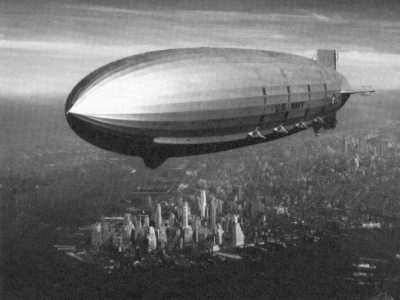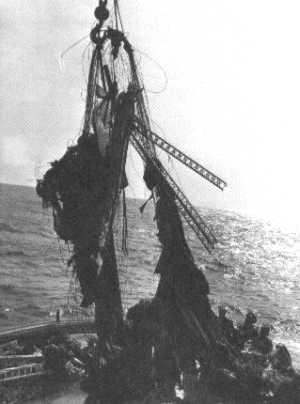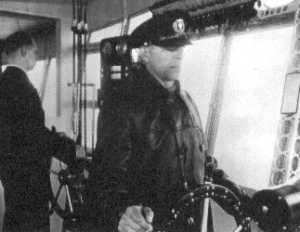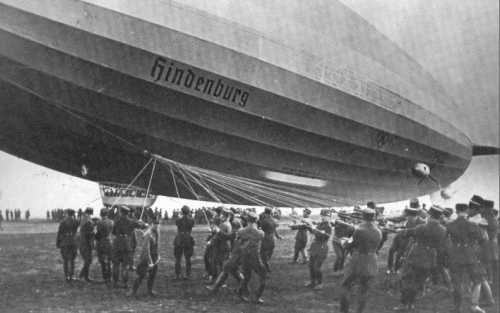|
The End of the
Airship Era: The Hindenburg
Disaster
With the building of the Los Angeles, the German dirigible
industry was given a great
psychological boost, which
emboldened Eckener into building (with the help of funds
donated by the German
people) an even greater craft: the
L-127, to be known as the Graf Zeppelin.
Launched in 1928, the Graf
Zeppelin conducted regular flights across
the Atlantic to North and
South America, as well as several trips around the world and
to the Arctic region. On the
ship’s maiden voyage, Hugo Eckener
had to use all his experience and
piloting powers to maintain
control when the Graf Zeppelin was
caught in a storm over the East
Coast of the United States.
Lieutenant Rosendahl, the flier
who had escaped death in the crash of the Shenandoah,
was also on board.
In 1929 the British finally reentered the airship
arena with two immense airships:
the R-100 and the R-lO1.
The R-100 was caught in a storm over the St. Lawrence
Seaway during its maiden
voyage to Canada; the dirigible
barely made it back to England and was placed in its
hangar as the authorities waited to see how the
R-1O1, boasted to be safe enough
to have an enclosed smoking
room, would fare on its trip to India. Unfortunately,
a new device that
controlled the distribution of ballast
water did not function properly, forcing the ship to
fly at very
low altitudes. As the airship at
very low altitudes.
As the airship passed over the
French town of Beauvais, it struck a church steeple and
exploded. Forty-eight passengers were burned almost beyond
recognition. The British did not need any further evidence
that the airships were unviable; the R-100, which was
awaiting repairs, was summarily dismantled. But the United
States was not swayed, and the ever-optimistic Admiral
Moffet pointed to the U.S. supply of helium as the reason
that no similar tragedy would occur with an American
dirigible. The navy ordered two airships that were to be the
largest yet produced: each nearly eight hundred feet (244m)
long with a capacity of 6.5 million cubic feet (182,000
cubic in).

The Macon, launched in 1933 (seen here
over Manhattan),
was really a flying aircraft carrier, able to carry,
service, and launch
five fighters that could return and land.
In August 1931 the ZRS-4, the Akron, took
its place alongside the Los Angeles at Lakehurst. Earlier in
the year, the Empire State Building had been completed and
its roof structure was designed to be a mooring for the Los
Angeles and later for the Akron. Although a test with a
smaller dirigible made it clear that the system was not
going to work, promotional photographs showing the Los
Angeles docking at the top of the Empire State Building were
published in newspapers around the country, sometimes
without the photograph being identified as a “photographic
composite.”
On April 3, 1933, the Akron was on a
flight off the Jersey shore, when it crashed into the
Atlantic and sank quickly. Seventy-seven crew members were
killed; the three survivors had to swim up from under the
craft to the surface to save themselves. This disaster was
the worst in the history of dirigible flight, and Admiral
Moffett, who had called the Akron “the safest dirigible ever
built” was not available to defend the program—he was among
the fatalities. Lieutenant Rosendahl, who had been slated to
captain the ship in the flight, had been replaced at the
last minute, and thus escaped death in a dirigible disaster
for the third time.
The navy’s second great dirigible, the
Macon, was a bit smaller and sleeker than the Akron; it was
also faster, being able to cruise in still air at
eighty-five miles per hour (l37kph). On February 12, 1935,
the Macon was practicing manoeuvres off the California coast
when it encountered a storm and crashed into the Pacific.
This time, eighty-one of the eighty-three crew members were
rescued. The Naval Court of Inquiry rendered the same
judgment about the Macon crash as it did of the Akron’s: the
crashes were not caused by structural problems with the
aircraft. But this time Congress suspended the program, and
the United States did not build another dirigible until
after World War II.

In spite of the loss of
seventy of the seventy-three aboard the Macon’s
sister ship, the Akron, when the
latter crashed into the Atlantic off the New Jersey coast
(here, rescuers survey the
Akron’s wreckage), the builders of the Macon
believed that the ship was safer because it had
multiple gas cells instead
of one large cell.
On February
12, 1935, the Macon also
crashed (under the same captain), this time into the
Pacific, with only
three fatalities (among a crew of eighty-three).

The Germans prided themselves in
developing sophisticated controls for their Zeppelins.
Ludwig Felber, who was a junior elevatorman at the wheel of the
Hindenburg on its final voyage,
is seen here at the controls of the
airship on an earlier Atlantic crossing.

Landing was a problem
the great airships never
solved. Ground crews had to pull the ship to its
mooring in scenes that seemed to be out of films
about Egyptian slaves.
The great airship swayed gently, even in a light
breeze, while passengers were
disembarking.
When Hitler came to power in Germany,
neither he nor Hermann Goring, the head of the Luftwaffe
(Germany’s air force), believed that dirigibles had any
value either as military or commercial aircraft. They
allowed the propaganda minister, headed by Josef Goebbels,
to take charge of the two mammoth Zeppelins then in service
under German control: the Graf Zeppelin and the newly
launched Hindenburg, the ultimate luxury airship, which was
put in service in March 1936.
Both ships were designed to be
run with helium, but the United States had already placed a
ban on exporting any of its helium supply, so hydrogen had
to be used instead. The Germans used these ships as
instruments of propaganda and espionage as the ships
criss-crossed the globe during the 1936 season, flying north
of the equator from May to September, and in the Southern
Hemisphere the rest of the year. During the 1936 Olympics,
which were held in Germany, the Hindenburg was everywhere,
providing a sinister psychological edge for German athletes
as it hovered over the games. In May 1937, after a late
summer run to Rio de Janeiro, the Hindenburg began its
service to the United States with a flight from Berlin
to New York.
On May 6, as it approached Lakehurst, it
waited for a squall to pass (as many other dirigibles had
done in the past). At 7:20 in the evening, the Hindenburg
headed for New Jersey and prepared to tie up at the mooring
tower. What happened next has been the subject of many
hundreds of hours of investigation and speculation. What was
apparent to the eye and to the camera (and what was
described by radio reporter Herb Morrison in one of
broadcasting’s most unforgettable moments) was that an
explosion engulfed the rear of the dirigible and quickly
spread to the entire ship, bringing it crashing to the
ground in flames.
The manifest listed ninety-seven
passengers, unusually large because it included trainees for
the Graf Zeppelin II, then under construction. Commanding
the flight was Captain Max Pruss, one of the Zeppelin
Company’s most experienced pilots, and along for the flight
(supervising the training program) was the company’s premier
pilot, Ernst Lehmann.
Of the ninety-seven aboard,
thirty-six died, including thirteen “civilian” (paying)
passengers, the first passengers of this kind killed in a
dirigible accident. (Past fatalities had been crew members
and military personnel, never paying passengers.) Captain
Pruss was saved, but Captain Lehmann staggered out of the
fire only to die in the hospital a few hours later. Before
he died, however, he was interviewed by one of the
investigators sent hastily to Lakehurst to determine what
had happened—none other than Charles Rosendahl. As Lehmann
lay dying, he muttered to Rosendahl that the explosion must
have been caused by an incendiary bullet shot from the
ground. Lehmann’s dying words, “It must have been an
infernal machine,” were often quoted, though no one was
quite sure what he meant. The Germans conducted an elaborate
Nazi funeral in New Jersey for the victims, milking the
occasion for maximum propaganda and implying that the
tragedy could have been averted if the United States had
been willing to sell Germany some of its helium.
When Secretary of the Interior Harold
Ickes refused to let Germany have any helium, Hugo Eckener
came to Washington to appeal to him personally. At first,
Ickes relented, and tankers were dispatched from Germany.
Before the pickup could be made, however, Hitler annexed
Austria in March 1938, and Ickes, convinced that the Nazis
were bent on war, rescinded the order.
Right up to the
invasion of Poland by Germany in September 1939, U.S.
agencies pressured Ickes to let the Germans have the helium.
When war came, Ickes gloated that he had been right all
along. The Los Angeles was dismantled and sold for scrap. In
Germany, the two Graf Zeppelins were stripped of anything
that could be used in aircraft, and then the Germans did
what the Allied countries had threatened to do since the end
of World War I: they levelled the Zeppelin hangars at
Frankfurt and closed down the factory at Friedrichshafen.
The age of the great airships had come to an end.



A sequence of news photos of the Hindenburg disaster.
Newspaper readers, seeing only the centre
photo, believed the airship had crashed into the mooring
tower in the foreground had exploded when a spark of static
electricity from the tower ignited the hydrogen. The other
photos show however, that the centre photo is misleading and
that the craft was in fact well away from the tower at the
time of the initial explosion. (Otherwise, the men seen at
the top of the tower in silhouette would have to have been
several stories taller) Also, the ground lines are dangling
from the airship’s nose, while the explosion begins in the
stern. The accident was caused by the new paint used
on the Hindenburg which contained an explosive mixture.
The static electricity at the prevailing weather conditions
would have been sufficient to have triggered the
fire.
|
